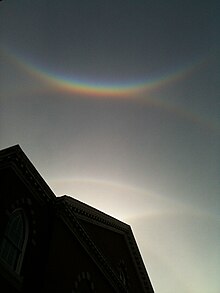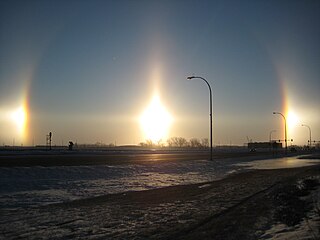
A sun dog or mock sun, also called a parhelion in atmospheric science, is an atmospheric optical phenomenon that consists of a bright spot to one or both sides of the Sun. Two sun dogs often flank the Sun within a 22° halo.

A halo is an optical phenomenon produced by light interacting with ice crystals suspended in the atmosphere. Halos can have many forms, ranging from colored or white rings to arcs and spots in the sky. Many of these appear near the Sun or Moon, but others occur elsewhere or even in the opposite part of the sky. Among the best known halo types are the circular halo, light pillars, and sun dogs, but many others occur; some are fairly common while others are extremely rare.

The antisolar point is the abstract point on the celestial sphere directly opposite the Sun from an observer's perspective. This means that the antisolar point lies above the horizon when the Sun is below it, and vice versa. On a sunny day, the antisolar point can be easily found; it is located within the shadow of the observer's head. Like the zenith and nadir, the antisolar point is not fixed in three-dimensional space, but is defined relative to the observer. Each observer has an antisolar point that moves as the observer changes position.

A moon dog or mock moon, also called a paraselene in meteorology, is an atmospheric optical phenomenon that consists of a bright spot to one or both sides of the Moon. They are exactly analogous to sun dogs.

A rainbow is an optical phenomenon caused by refraction, internal reflection and dispersion of light in water droplets resulting in a continuous spectrum of light appearing in the sky. The rainbow takes the form of a multicoloured circular arc. Rainbows caused by sunlight always appear in the section of sky directly opposite the Sun. Rainbows can be caused by many forms of airborne water. These include not only rain, but also mist, spray, and airborne dew.

A fog bow, sometimes called a white rainbow, is a similar phenomenon to a rainbow; however, as its name suggests, it appears as a bow in fog rather than rain. Because of the very small size of water droplets that cause fog—smaller than 0.05 millimeters (0.0020 in)—the fog bow has only very weak colors, with a red outer edge and bluish inner edge. The colors fade due to being smeared out by the diffraction effect of the smaller droplets.

A circumhorizontal arc is an optical phenomenon that belongs to the family of ice halos formed by the refraction of sunlight or moonlight in plate-shaped ice crystals suspended in the atmosphere, typically in actual cirrus or cirrostratus clouds. In its full form, the arc has the appearance of a large, brightly spectrum-coloured band running parallel to the horizon, located far below the Sun or Moon. The distance between the arc and the Sun or Moon is twice as far as the common 22-degree halo. Often, when the halo-forming cloud is small or patchy, only fragments of the arc are seen. As with all halos, it can be caused by the Sun as well as the Moon.

A parhelic circle is a type of halo, an optical phenomenon appearing as a horizontal white line on the same altitude as the Sun, or occasionally the Moon. If complete, it stretches all around the sky, but more commonly it only appears in sections. If the halo occurs due to light from the Moon rather than the Sun, it is known as a paraselenic circle.

A 22° halo is an atmospheric optical phenomenon that consists of a halo with an apparent diameter of approximately 22° around the Sun or Moon. Around the Sun, it may also be called a sun halo. Around the Moon, it is also known as a moon ring, storm ring, or winter halo. It forms as sunlight or moonlight is refracted by millions of hexagonal ice crystals suspended in the atmosphere. Its radius, as viewed from Earth, is roughly the length of an outstretched hand at arm's length.

Tangent arcs are a type of halo, an atmospheric optical phenomenon, which appears above and below the observed Sun or Moon, tangent to the 22° halo. To produce these arcs, rod-shaped hexagonal ice crystals need to have their long axis aligned horizontally.

A circumscribed halo is a type of halo, an optical phenomenon typically in the form of a more or less oval ring that circumscribes the circular 22° halo centred on the Sun or Moon. As the Sun rises above 70° it essentially covers the 22° halo. Like many other halos, it is slightly reddish on the inner edge, facing the Sun or Moon, and bluish on the outer edge.
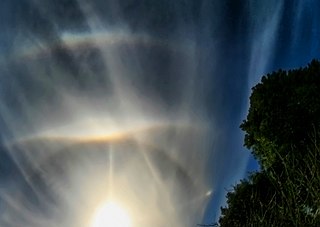
A supralateral arc is a comparatively rare member of the halo family which in its complete form appears as a large, faintly rainbow-colored band in a wide arc above the sun and appearing to encircle it, at about twice the distance as the familiar 22° halo. In reality, however, the supralateral arc does not form a circle and never reaches below the sun. When present, the supralateral arc touches the circumzenithal arc from below. As in all colored halos, the arc has its red side directed towards the sun, its blue part away from it.
An infralateral arc is a rare halo, an optical phenomenon appearing similar to a rainbow under a white parhelic circle. Together with the supralateral arc they are always located outside the seldom observable 46° halo, but in contrast to supralateral arcs, infralateral arcs are always located below the parhelic circle.

A 46° halo is a rare atmospheric optical phenomenon that consists of a halo with an apparent radius of approximately 46° around the Sun. At solar elevations of 15–27°, 46° halos are often confused with the less rare and more colourful supralateral and infralateral arcs, which cross the parhelic circle at about 46° to the left and right of the sun.

A Parry arc is a rare halo, an optical phenomenon which occasionally appears over a 22° halo together with an upper tangent arc.
The Kern arc is an extremely rare atmospheric optical phenomenon belonging to the family of ice crystal halos. It is a complete and faint circle around the zenith, in contrast to the related and much more common circumzenithal arc, which is only ever a partial circle.
A subhelic arc is a rare halo, formed by internal reflection through ice crystals, that curves upwards from the horizon and touches the tricker arc above the anthelic point. Subhelic arcs result from ray entrance and exit through prism end faces with two intermediate internal reflections.
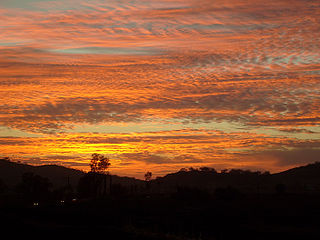
Atmospheric optics is "the study of the optical characteristics of the atmosphere or products of atmospheric processes .... [including] temporal and spatial resolutions beyond those discernible with the naked eye". Meteorological optics is "that part of atmospheric optics concerned with the study of patterns observable with the naked eye". Nevertheless, the two terms are sometimes used interchangeably.

A Lowitz arc is an optical phenomenon that occurs in the atmosphere; specifically, it is a rare type of ice crystal halo that forms a luminous arc which extends inwards from a sun dog (parhelion) and may continue above or below the sun.
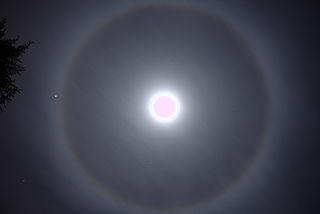
Optical phenomena are any observable events that result from the interaction of light and matter.
